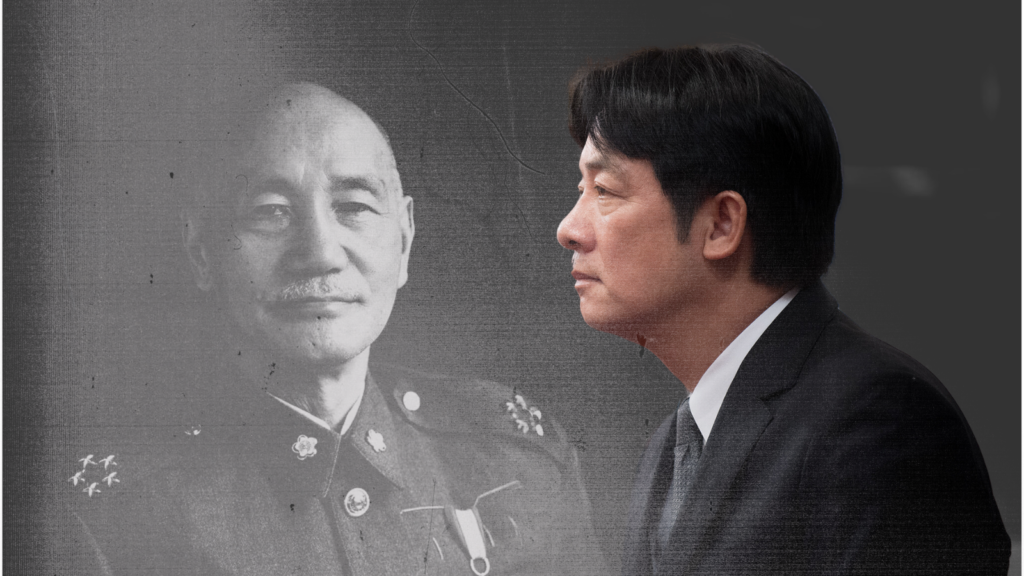In the run up to the inauguration of Taiwan’s incoming President Lai Ching-te on May 20, several English-language media outlets have picked up on a decades-long debate about what to do with the many Chiang Kai-shek statues scattered across the island. The specific issue concerned a question raised by a Democratic Progressive Party (DPP) legislator about the implementation of statue removal recommendations by the now defunct Transitional Justice Commission (TJC).
And whilst this debate keeps returning to the most controversial statue of them all – the six-meter tall statue of Chiang Kai-shek at his Memorial Hall in Taipei – the likelihood of this being removed remains small. This is because of several historical factors that constrain the extent of retributive measures in any state that tries to pursue transitional justice.
In fact, any progress in retributive justice under Lai remains unlikely, and the new administration may well just try and capitalize on its existing achievements by incorporating them into its public diplomacy toolkit instead. But first, let’s discuss what is meant by transitional justice.
228, White Terror and Taiwan’s Pursuit of Transitional Justice
To put it simply, transitional justice refers to measures adopted by a new regime to address the human rights abuses of the previous regime. Because of this, it is often discussed in connection to democratization, although the states pursuing transitional justice do not have to be democracies. Indeed, transitional justice can be pursued in post-conflict societies by states that had transitioned from one form of authoritarian regime to another.
Transitional justice can take several forms, some being restorative (i.e., focused on victims and reconciliation) and others retributive (i.e., focused on perpetrators and punishment). South Africa’s Truth and Reconciliation Commission (TRC), for example, fell more on the restorative side, whereas the International Criminal Tribunal for Rwanda (ICTR) fell more on the retributive side.
In the case of Taiwan, transitional justice has focused on human rights abuses committed by the Kuomintang (KMT) regime under the two Chiangs – Chiang Kai-shek and Chiang Ching-kuo. Although the administration of the outgoing President Tsai Ing-wen has expanded the scope of transitional justice to the Japanese colonial regime that had committed mass atrocities against Taiwan’s indigenous population, the period under the unitary rule of the KMT remained the focus of Tsai’s transitional justice policies, not least due to the DPP’s own electoral interests. More specifically, the focal point continues to be the infamous 228 Incident (1947), named as such because it had occurred on February 28, and the ensuing White Terror period (1949-1987).
The 228 Incident refers to a clash between the KMT’s monopoly bureau agents and a street vendor accused of an illegal sale of cigarettes that had turned into an island-wide uprising of “benshengren” against what was effectively a “waishengren” regime; benshengren being native Taiwanese (i.e., Taiwanese of Han Chinese descent that came to Taiwan prior to the KMT’s arrival) and waishengren mainlanders (i.e., Taiwanese that came with the KMT). The White Terror covers a longer period, as it refers to mass atrocities committed by the KMT against both benshengren and waishengren populations during Taiwan’s martial law era.
When it comes to the form of transitional justice, most of Taiwan’s measures are restorative. However, the Tsai administration has also passed the island’s first explicitly retributive act – the “Party Assets Act” – that targets the assets obtained illegally by the KMT and its affiliate organizations under martial law.
The administration, however, needed to expend significant political capital to pass the legislation, which was heavily opposed by the KMT. In fact, the passage of this act would have not been possible without a DPP-controlled legislature. Moreover, with the KMT repeatedly accusing the DPP of “Green Terror,” the ensuing controversy has further divided the Taiwanese public (and its attitudes towards transitional justice) along party lines, thus complicating the pursuit of retributive justice moving forward.
Lai’s Chen Dilemma
Based on the outcome of the January elections, Lai (unlike Tsai) will not be able to rely on the DPP’s legislative majority to push through controversial measures, such as the removal of the colossal Chiang statue. This means that, after eight years of the DPP’s legislative majority, the DPP under Lai will be in the same situation as it was under Chen Shui-bian when the KMT-dominated Legislative Yuan blocked any major attempts at pursuing retributive justice.
And whilst the Chen administration succeeded in renaming the Chiang Kai-Shek Memorial Hall the National Taiwan Democracy Memorial Hall, this was reversed back to its original name once the KMT came back to power. Moreover, it was arguably Chen’s pursuit of such controversial moves, including his repeated public references to Chiang Kai-shek’s responsibility for the 228 Incident, that had allowed the KMT to successfully embed the idea of the DPP’s political persecution of the KMT in the public discourse on transitional justice.
Add the DPP’s loss of its legislative majority in the January elections to the list of factors that had constrained the extent of retributive justice even under Tsai (and indeed all previous administrations), and Lai’s inability to pursue any new retributive measures becomes even clearer. Let’s go back to the legacy of the two Chiangs to explain this further.
The KMT regime became less repressive as time passed by, especially after Chiang Ching-kuo came to power. Taiwan also underwent its economic miracle (i.e., rapid economic growth with a relatively even distribution of wealth), which had brought the island global recognition. All of this meant that at the time of Taiwan’s democratic transition, which was spurred by the KMT elites themselves who then stayed in power for another 13 years, a significant portion of Taiwan’s population saw the KMT regime as legitimate. This complicated any attempts at punishing the former perpetrators.
There is also the factor of divided historical memory, with the benshengren and waishengren Taiwanese having held (and to some extent still holding) different interpretations of the 228 Incident and White Terror. The memory of the 228 Incident is particularly divisive, as unlike the memory of the White Terror, which saw the persecution of both ethnic groups, the 228 Incident is mostly associated with a brutal persecution of benshengren by the waishengren regime. Although the benshengren-waishengren divide no longer plays a major role in Taiwanese society, this does not mean that disagreements about the interpretations of these historical events ceased to exist. On the contrary, the Chiang Kai-shek statue debate is just one of many controversial debates that have been ongoing since the island’s democratization, with the debate concerning history textbook revisions being yet another example of these.
Transitional Justice as a Diplomatic Tool?
A Chen-like push for retributive justice is thus unlikely to be high on Lai’s agenda, not least because of Lai’s interest in avoiding further comparisons to Chen. After all, his early political remarks about Taiwan’s independence that were compared to those of Chen had significantly complicated his electoral campaign. Instead, Lai will likely focus on consolidating the existing measures and framing the issue of transitional justice more broadly in terms of human rights. Indeed, the naming of what is effectively the TJC’s successor as the Department of Human Rights and Transitional Justice suggests just that.
And if there is one thing that Lai could learn from Chen, it is Chen’s emphasis on the so-called “diplomacy of democracy” in Taiwan’s foreign policy. The subsequent administrations have further emphasized Taiwan’s normative power status, especially in the island’s relations with other normative powers like the EU. Human rights diplomacy is increasingly emerging as a new strand of Taiwan’s public diplomacy, and the exchange of best practices concerning the pursuit of transitional justice could well become part of this. Indeed, Taiwan has already hosted several transitional justice delegations from countries like Germany that have their own experiences in pursuing transitional justice.
Germany is, however, not the only EU country that has pursued transitional justice. Several CEE countries have done so themselves, with the Czech Republic standing out as the CEE state that has pursued the most comprehensive measures in this area. Moreover, since the CEE countries’ democratic transitions and pursuits of transitional justice share more similarities with Taiwan than Germany does, the exchanges on the matter could potentially be more fruitful for both sides. As the Czech Republic is already open to cooperating with Taiwan across several domains, the incorporation of transitional justice into Czech-Taiwanese human rights diplomacy may well be the next step to consider, especially as the current focus on economic diplomacy and cooperation in semiconductors may soon be challenged by Taiwan’s own need to diversify its economy.
The article was originally published by CHOICE.








